2015 JEEP GRAND CHEROKEE maintenance
[x] Cancel search: maintenancePage 3 of 717
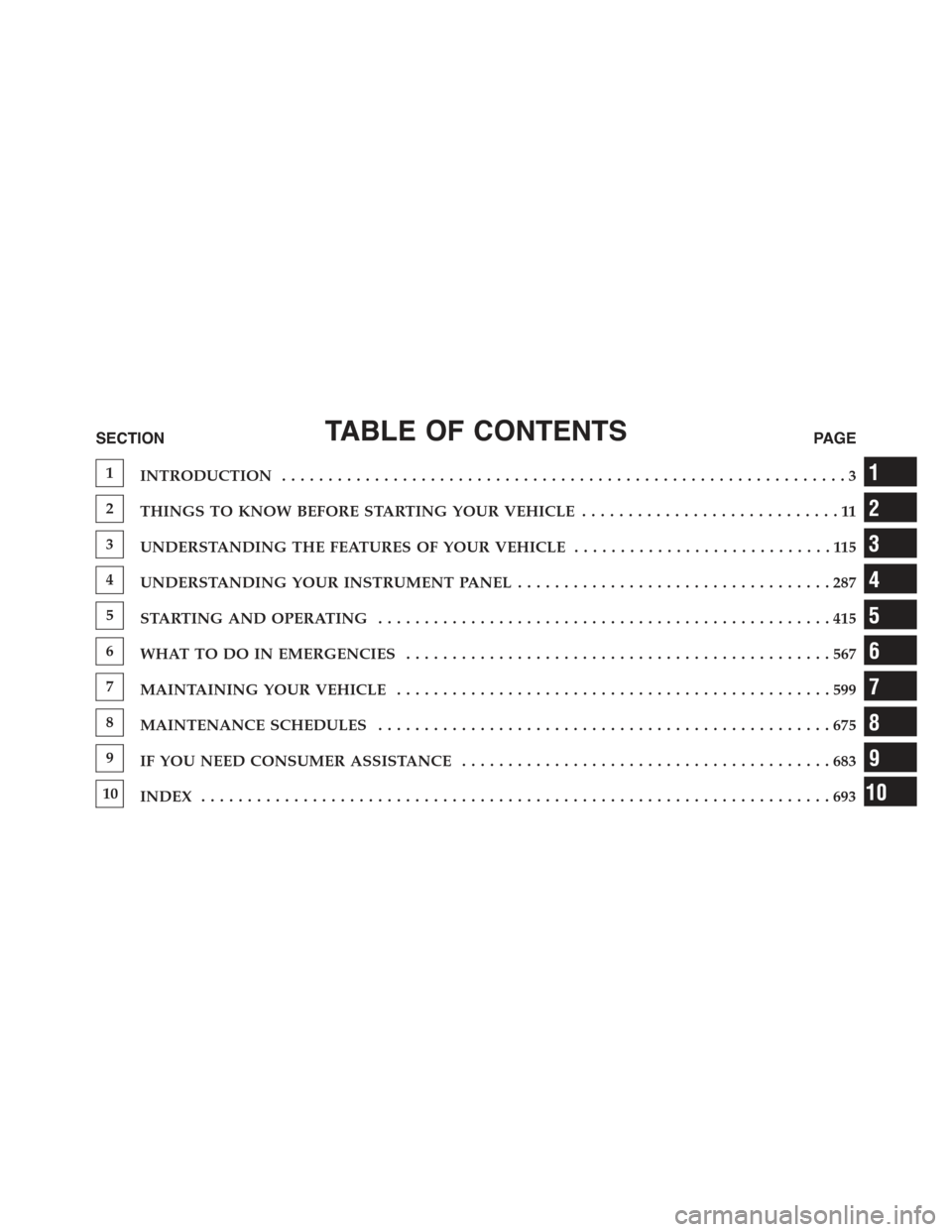
TABLE OF CONTENTSSECTIONPAGE
1INTRODUCTION.............................................................3
2THINGS TO KNOW BEFORE STARTING YOUR VEHICLE............................11
3UNDERSTANDING THE FEATURES OF YOUR VEHICLE. . . . . . . . . . . . . . . . . . . . . . . . . . . . 115
4UNDERSTANDING YOUR INSTRUMENT PANEL. . . . . . . . . . . . . . . . . . . . . . . . . . . . . . . . . . 287
5STARTING AND OPERATING. . . . . . . . . . . . . . . . . . . . . . . . . . . . . . . . . . . . . . . . . . . . . . . . . 415
6WHAT TO DO IN EMERGENCIES. . . . . . . . . . . . . . . . . . . . . . . . . . . . . . . . . . . . . . . . . . . . . . 567
7MAINTAINING YOUR VEHICLE. . . . . . . . . . . . . . . . . . . . . . . . . . . . . . . . . . . . . . . . . . . . . . . 599
8MAINTENANCE SCHEDULES. . . . . . . . . . . . . . . . . . . . . . . . . . . . . . . . . . . . . . . . . . . . . . . . . 675
9IF YOU NEED CONSUMER ASSISTANCE. . . . . . . . . . . . . . . . . . . . . . . . . . . . . . . . . . . . . . . . 683
10INDEX. . . . . . . . . . . . . . . . . . . . . . . . . . . . . . . . . . . . . . . . . . . . . . . . . . . . . . . . . . . . . . . . . . . . 693
1
2
3
4
5
6
7
8
9
10
Page 7 of 717
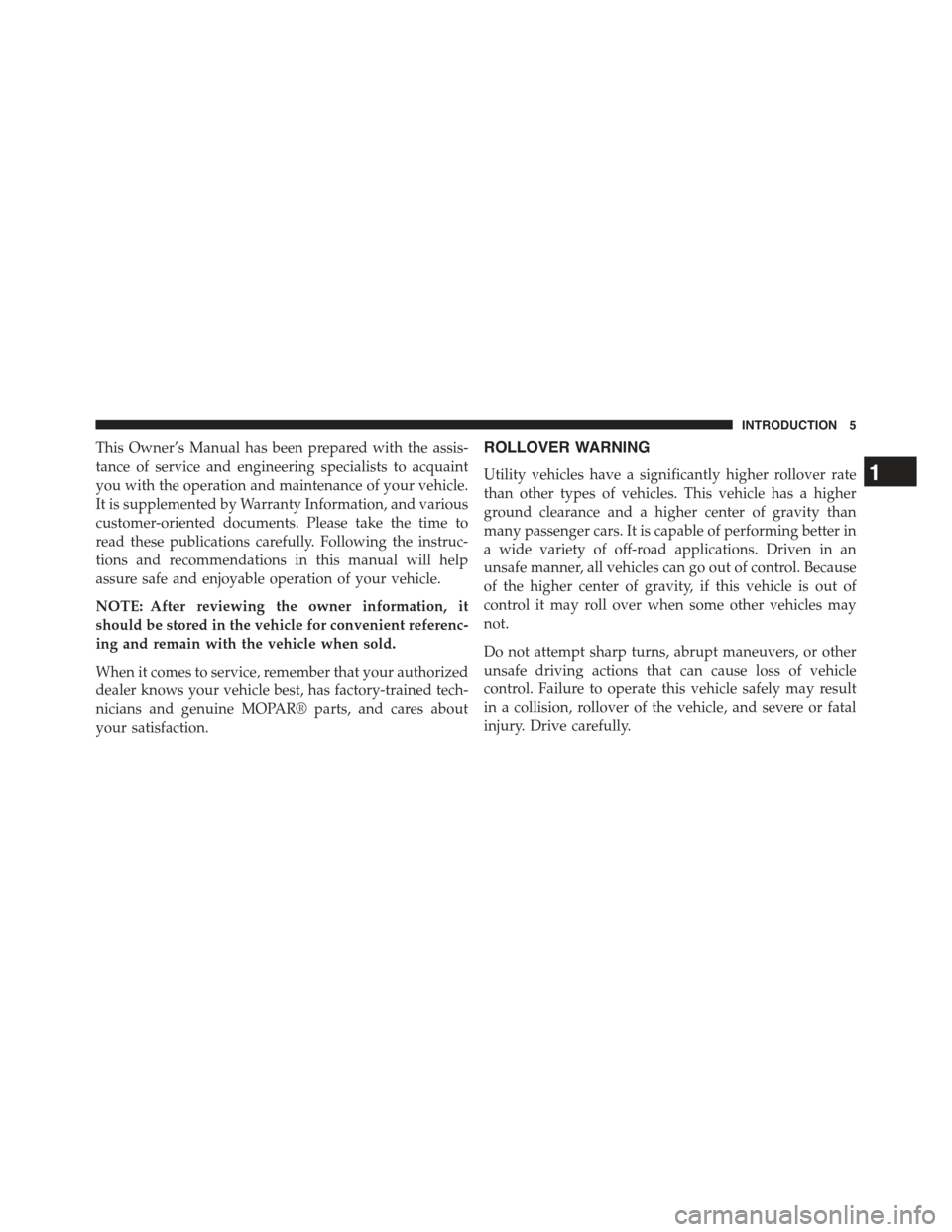
This Owner’s Manual has been prepared with the assis-
tance of service and engineering specialists to acquaint
you with the operation and maintenance of your vehicle.
It is supplemented by Warranty Information, and various
customer-oriented documents. Please take the time to
read these publications carefully. Following the instruc-
tions and recommendations in this manual will help
assure safe and enjoyable operation of your vehicle.
NOTE: After reviewing the owner information, it
should be stored in the vehicle for convenient referenc-
ing and remain with the vehicle when sold.
When it comes to service, remember that your authorized
dealer knows your vehicle best, has factory-trained tech-
nicians and genuine MOPAR® parts, and cares about
your satisfaction.
ROLLOVER WARNING
Utility vehicles have a significantly higher rollover rate
than other types of vehicles. This vehicle has a higher
ground clearance and a higher center of gravity than
many passenger cars. It is capable of performing better in
a wide variety of off-road applications. Driven in an
unsafe manner, all vehicles can go out of control. Because
of the higher center of gravity, if this vehicle is out of
control it may roll over when some other vehicles may
not.
Do not attempt sharp turns, abrupt maneuvers, or other
unsafe driving actions that can cause loss of vehicle
control. Failure to operate this vehicle safely may result
in a collision, rollover of the vehicle, and severe or fatal
injury. Drive carefully.
1
INTRODUCTION 5
Page 81 of 717
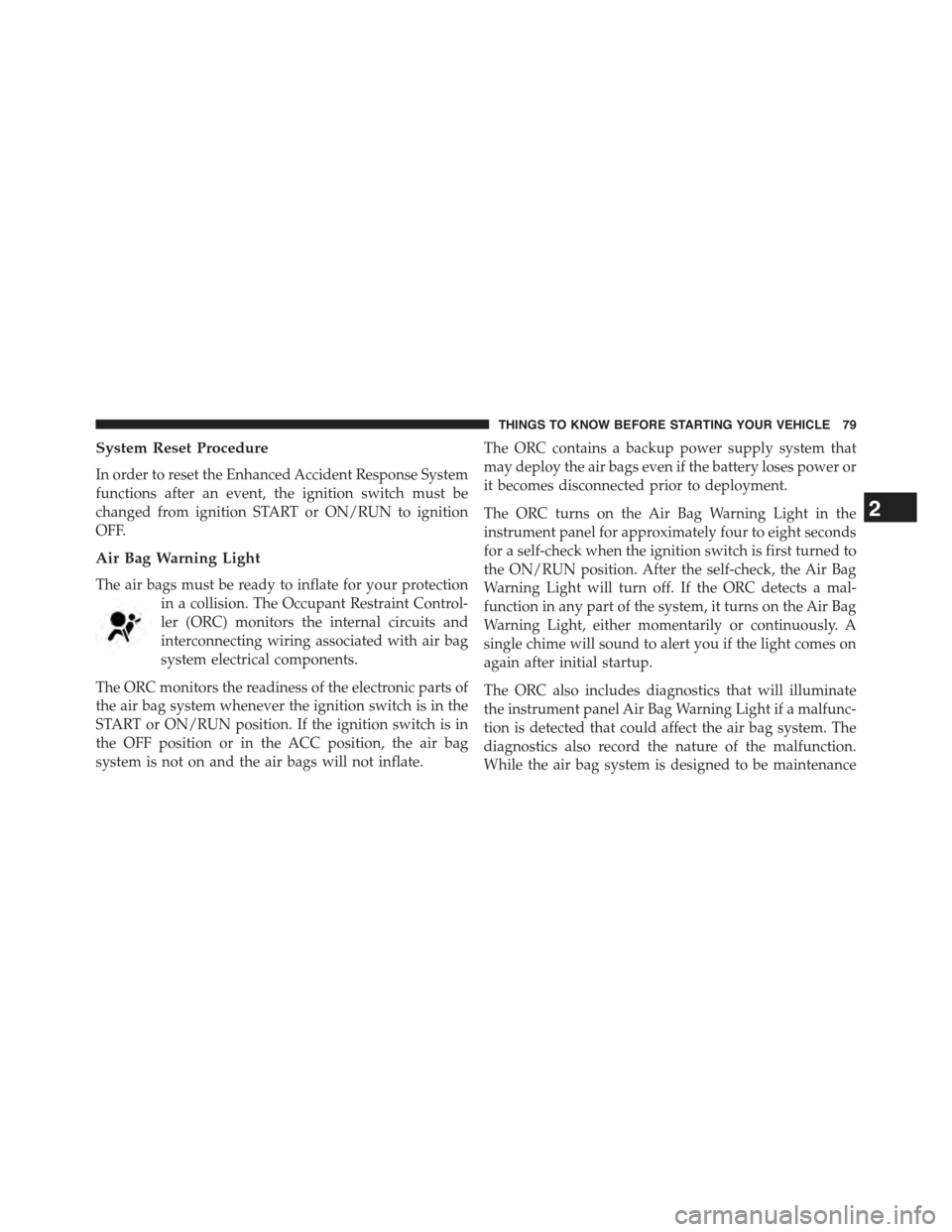
System Reset Procedure
In order to reset the Enhanced Accident Response System
functions after an event, the ignition switch must be
changed from ignition START or ON/RUN to ignition
OFF.
Air Bag Warning Light
The air bags must be ready to inflate for your protection
in a collision. The Occupant Restraint Control-
ler (ORC) monitors the internal circuits and
interconnecting wiring associated with air bag
system electrical components.
The ORC monitors the readiness of the electronic parts of
the air bag system whenever the ignition switch is in the
START or ON/RUN position. If the ignition switch is in
the OFF position or in the ACC position, the air bag
system is not on and the air bags will not inflate.
The ORC contains a backup power supply system that
may deploy the air bags even if the battery loses power or
it becomes disconnected prior to deployment.
The ORC turns on the Air Bag Warning Light in the
instrument panel for approximately four to eight seconds
for a self-check when the ignition switch is first turned to
the ON/RUN position. After the self-check, the Air Bag
Warning Light will turn off. If the ORC detects a mal-
function in any part of the system, it turns on the Air Bag
Warning Light, either momentarily or continuously. A
single chime will sound to alert you if the light comes on
again after initial startup.
The ORC also includes diagnostics that will illuminate
the instrument panel Air Bag Warning Light if a malfunc-
tion is detected that could affect the air bag system. The
diagnostics also record the nature of the malfunction.
While the air bag system is designed to be maintenance
2
THINGS TO KNOW BEFORE STARTING YOUR VEHICLE 79
Page 110 of 717
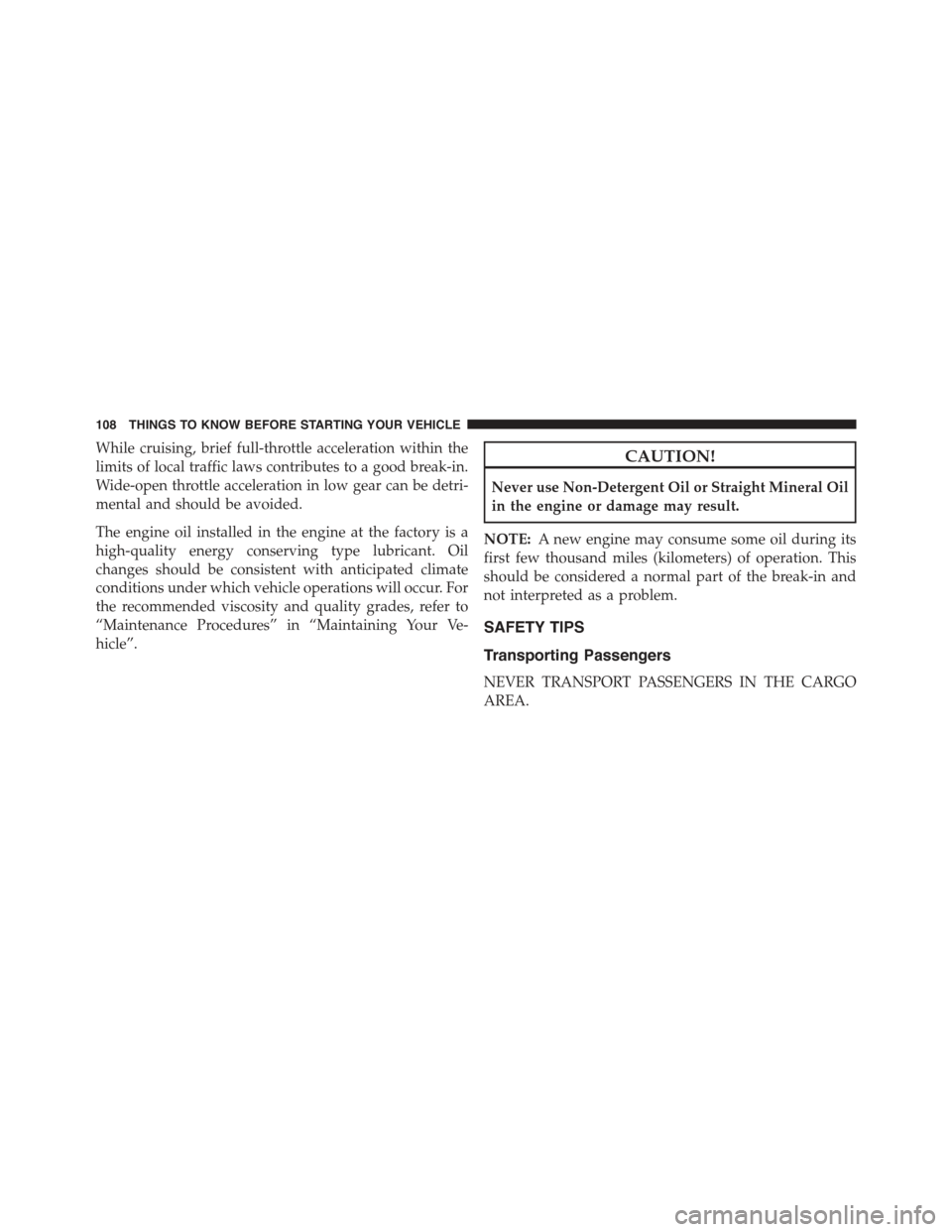
While cruising, brief full-throttle acceleration within the
limits of local traffic laws contributes to a good break-in.
Wide-open throttle acceleration in low gear can be detri-
mental and should be avoided.
The engine oil installed in the engine at the factory is a
high-quality energy conserving type lubricant. Oil
changes should be consistent with anticipated climate
conditions under which vehicle operations will occur. For
the recommended viscosity and quality grades, refer to
“Maintenance Procedures” in “Maintaining Your Ve-
hicle”.
CAUTION!
Never use Non-Detergent Oil or Straight Mineral Oil
in the engine or damage may result.
NOTE:A new engine may consume some oil during its
first few thousand miles (kilometers) of operation. This
should be considered a normal part of the break-in and
not interpreted as a problem.
SAFETY TIPS
Transporting Passengers
NEVER TRANSPORT PASSENGERS IN THE CARGO
AREA.
108 THINGS TO KNOW BEFORE STARTING YOUR VEHICLE
Page 120 of 717
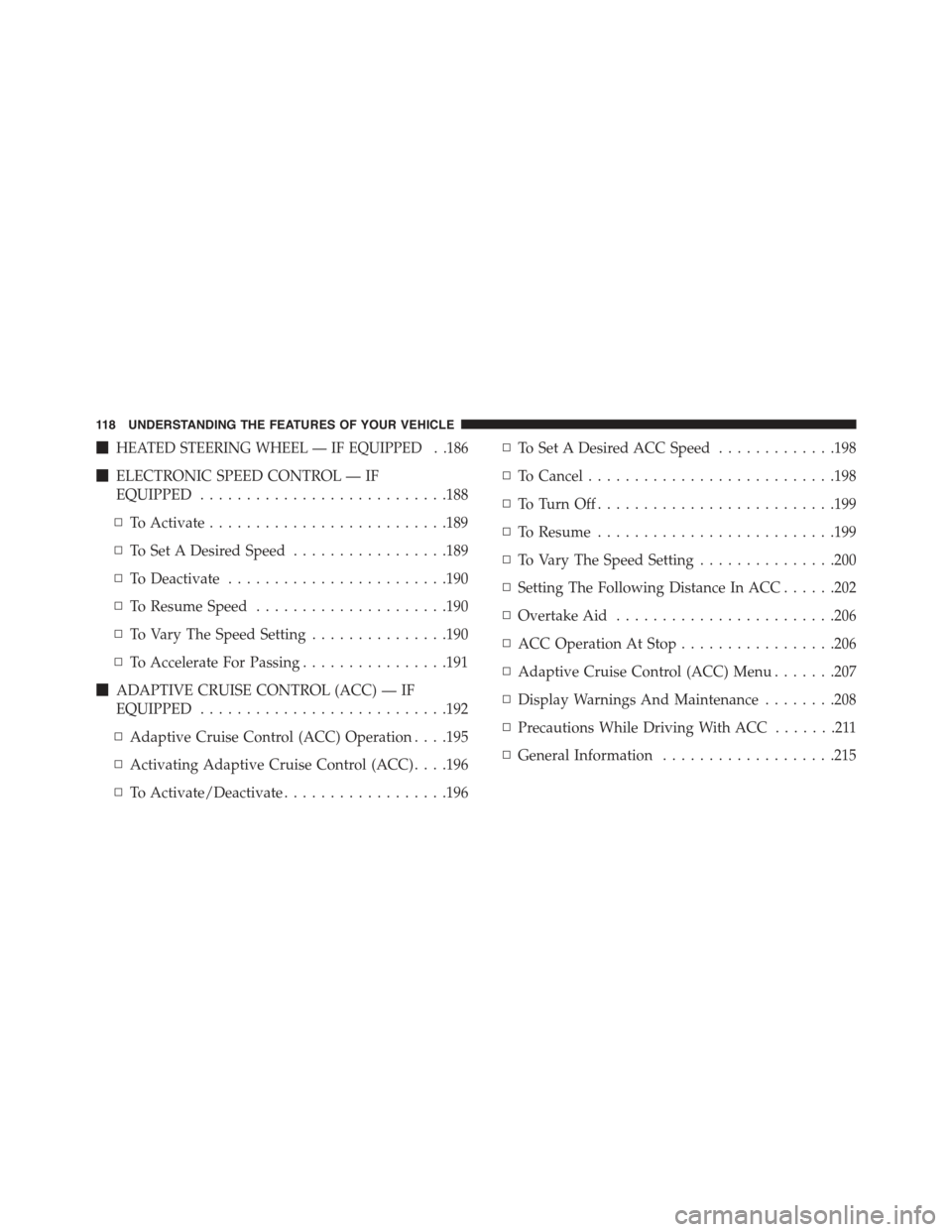
!HEATED STEERING WHEEL — IF EQUIPPED . .186
!ELECTRONIC SPEED CONTROL — IF
EQUIPPED...........................188
▫To Activate..........................189
▫To Set A Desired Speed.................189
▫To Deactivate........................190
▫To Resume Speed.....................190
▫To Vary The Speed Setting...............190
▫To Accelerate For Passing................191
!ADAPTIVE CRUISE CONTROL (ACC) — IF
EQUIPPED...........................192
▫Adaptive Cruise Control (ACC) Operation . . . .195
▫Activating Adaptive Cruise Control (ACC) . . . .196
▫To Activate/Deactivate..................196
▫To Set A Desired ACC Speed.............198
▫To Cancel...........................198
▫To Tu r n O f f . . . . . . . . . . . . . . . . . . . . . . . . ..199
▫To Resume..........................199
▫To Vary The Speed Setting...............200
▫Setting The Following Distance In ACC......202
▫Overtake Aid........................206
▫ACC Operation At Stop.................206
▫Adaptive Cruise Control (ACC) Menu.......207
▫Display Warnings And Maintenance........208
▫Precautions While Driving With ACC.......211
▫General Information...................215
11 8 U N D E R S TA N D I N G T H E F E AT U R E S O F Y O U R V E H I C L E
Page 122 of 717
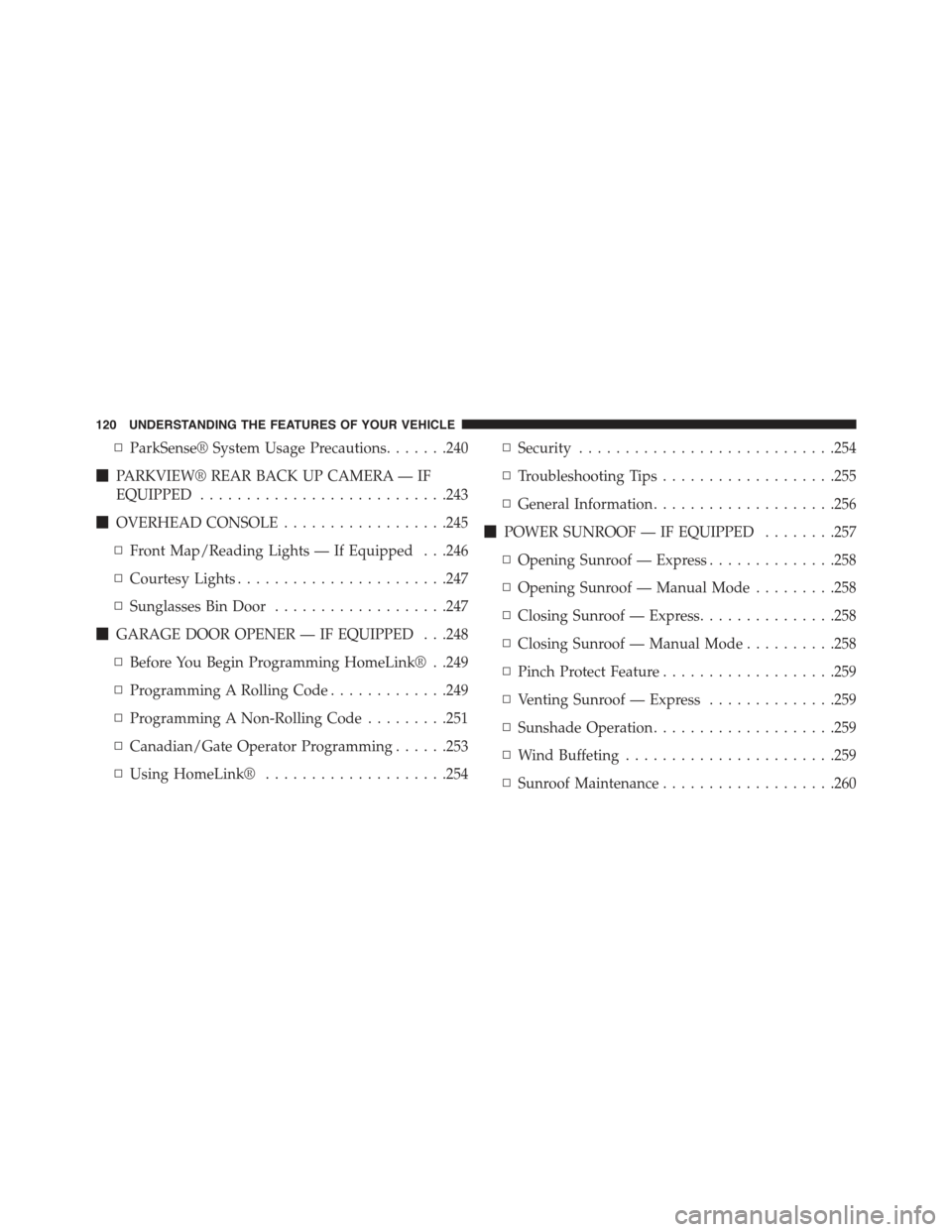
▫ParkSense® System Usage Precautions.......240
!PARKVIEW® REAR BACK UP CAMERA — IF
EQUIPPED...........................243
!OVERHEAD CONSOLE..................245
▫Front Map/Reading Lights — If Equipped . . .246
▫Courtesy Lights.......................247
▫Sunglasses Bin Door...................247
!GARAGE DOOR OPENER — IF EQUIPPED . . .248
▫Before You Begin Programming HomeLink® . .249
▫Programming A Rolling Code.............249
▫Programming A Non-Rolling Code.........251
▫Canadian/Gate Operator Programming......253
▫Using HomeLink®....................254
▫Security............................254
▫Troubleshooting Tips...................255
▫General Information....................256
!POWER SUNROOF — IF EQUIPPED........257
▫Opening Sunroof — Express..............258
▫Opening Sunroof — Manual Mode.........258
▫Closing Sunroof — Express...............258
▫Closing Sunroof — Manual Mode..........258
▫Pinch Protect Feature...................259
▫Venting Sunroof — Express..............259
▫Sunshade Operation....................259
▫Wind Buffeting.......................259
▫Sunroof Maintenance...................260
120 UNDERSTANDING THE FEATURES OF YOUR VEHICLE
Page 123 of 717
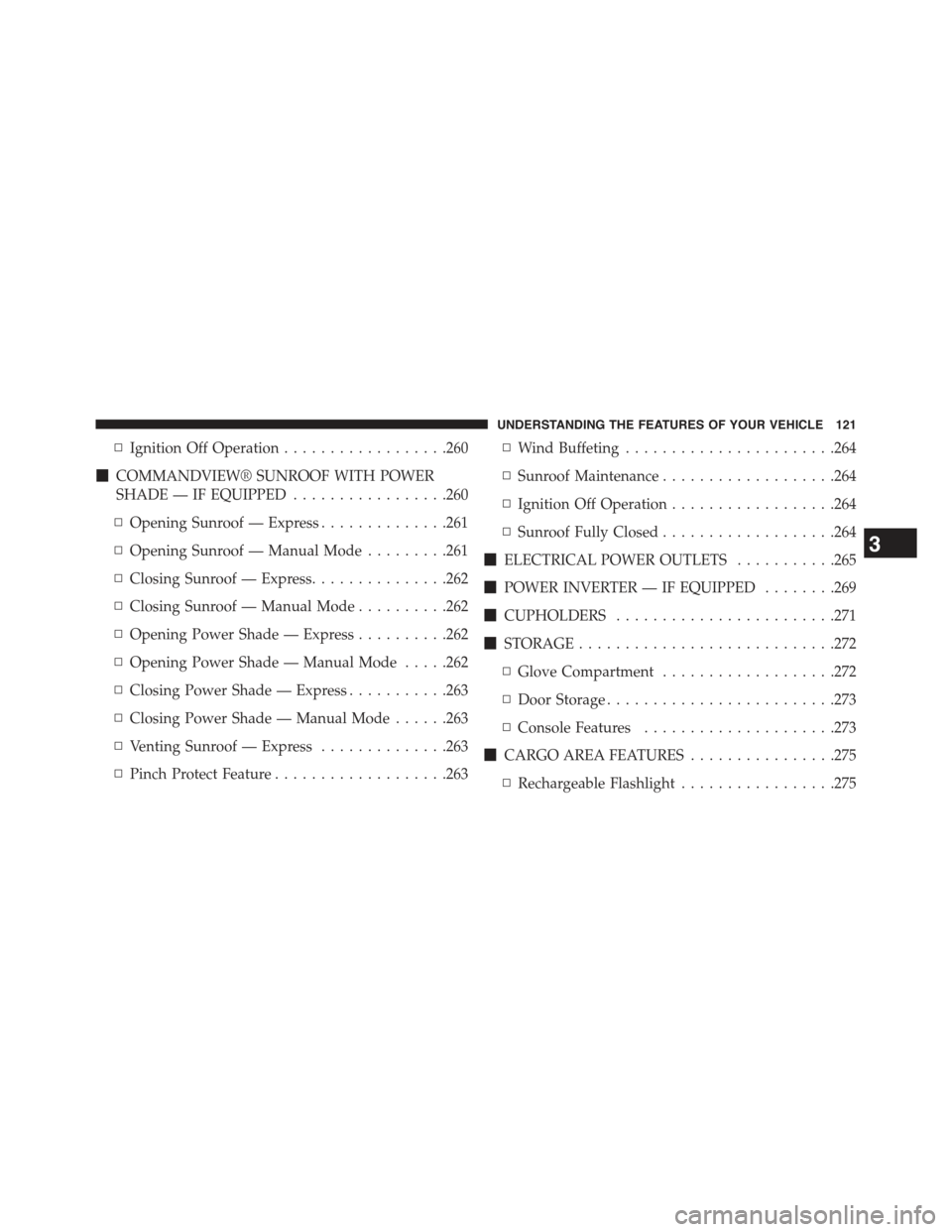
▫Ignition Off Operation..................260
!COMMANDVIEW® SUNROOF WITH POWER
SHADE — IF EQUIPPED.................260
▫Opening Sunroof — Express..............261
▫Opening Sunroof — Manual Mode.........261
▫Closing Sunroof — Express...............262
▫Closing Sunroof — Manual Mode..........262
▫Opening Power Shade — Express..........262
▫Opening Power Shade — Manual Mode.....262
▫Closing Power Shade — Express...........263
▫Closing Power Shade — Manual Mode......263
▫Venting Sunroof — Express..............263
▫Pinch Protect Feature...................263
▫Wind Buffeting.......................264
▫Sunroof Maintenance...................264
▫Ignition Off Operation..................264
▫Sunroof Fully Closed...................264
!ELECTRICAL POWER OUTLETS...........265
!POWER INVERTER — IF EQUIPPED........269
!CUPHOLDERS........................271
!STORAGE............................272
▫Glove Compartment...................272
▫Door Storage.........................273
▫Console Features.....................273
!CARGO AREA FEATURES................275
▫Rechargeable Flashlight.................275
3
UNDERSTANDING THE FEATURES OF YOUR VEHICLE 121
Page 210 of 717

•ACC Proximity Warning
•ACC Unavailable Warning
•The DID will return to the last display selected after
five seconds of no ACC display activity
Display Warnings And Maintenance
“Wipe Front Radar Sensor In Front Of Vehicle”
Warning
The “ACC/FCW Unavailable Wipe Front Radar Sensor”
warning will display and also a chime will indicate when
conditions temporarily limit system performance.
This most often occurs at times of poor visibility, such as
in snow or heavy rain. The ACC system may also become
temporarily blinded due to obstructions, such as mud,
dirt or ice. In these cases, the DID will display “ACC/
FCW Unavailable Wipe Front Radar Sensor” and the
system will deactivate.
The “ACC/FCW Unavailable Wipe Front Radar Sensor”
message can sometimes be displayed while driving in
highly reflective areas (i.e. tunnels with reflective tiles, or
ice and snow). The ACC system will recover after the
vehicle has left these areas. Under rare conditions, when
the radar is not tracking any vehicles or objects in its path
this warning may temporarily occur.
NOTE:If the “ACC/FCW Unavailable Wipe Front Radar
Sensor” warning is active Normal (Fixed Speed) Cruise
Control is still available. For additional information refer
to “Normal (Fixed Speed) Cruise Control Mode” in this
section.
If weather conditions are not a factor, the driver should
examine the sensor. It may require cleaning or removal of
an obstruction. The sensor is located in the center of the
vehicle behind the lower grille.
208 UNDERSTANDING THE FEATURES OF YOUR VEHICLE